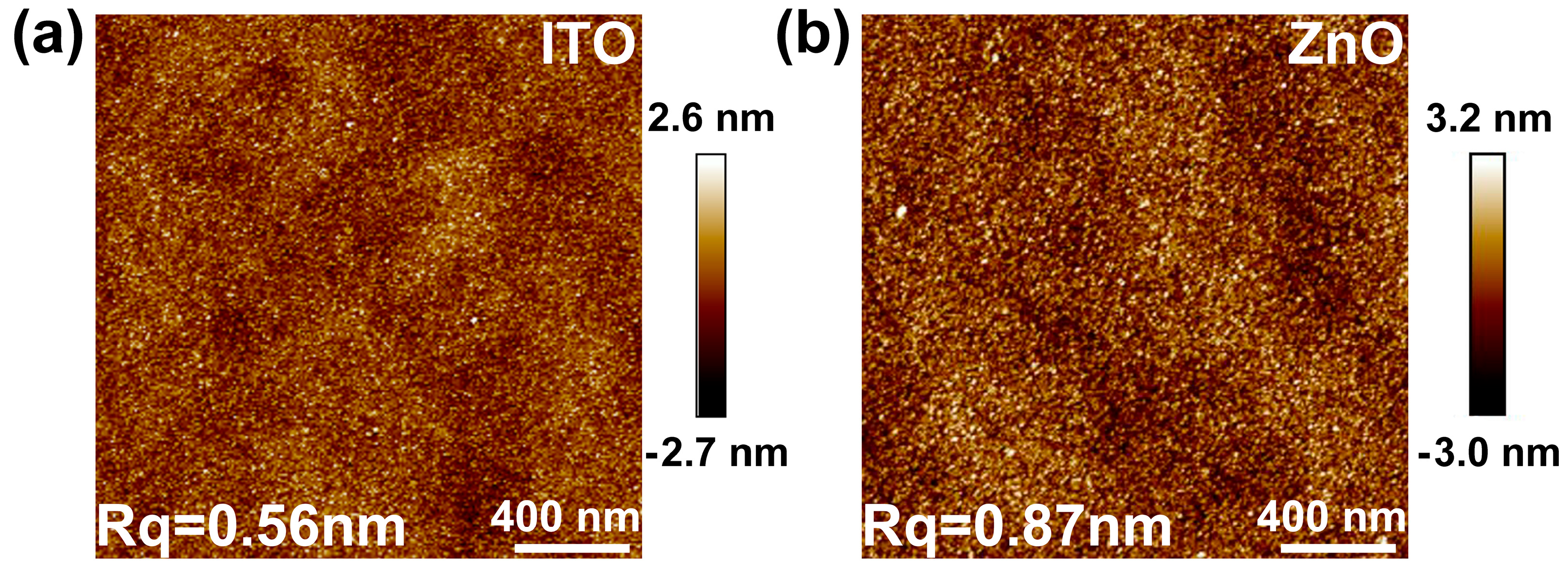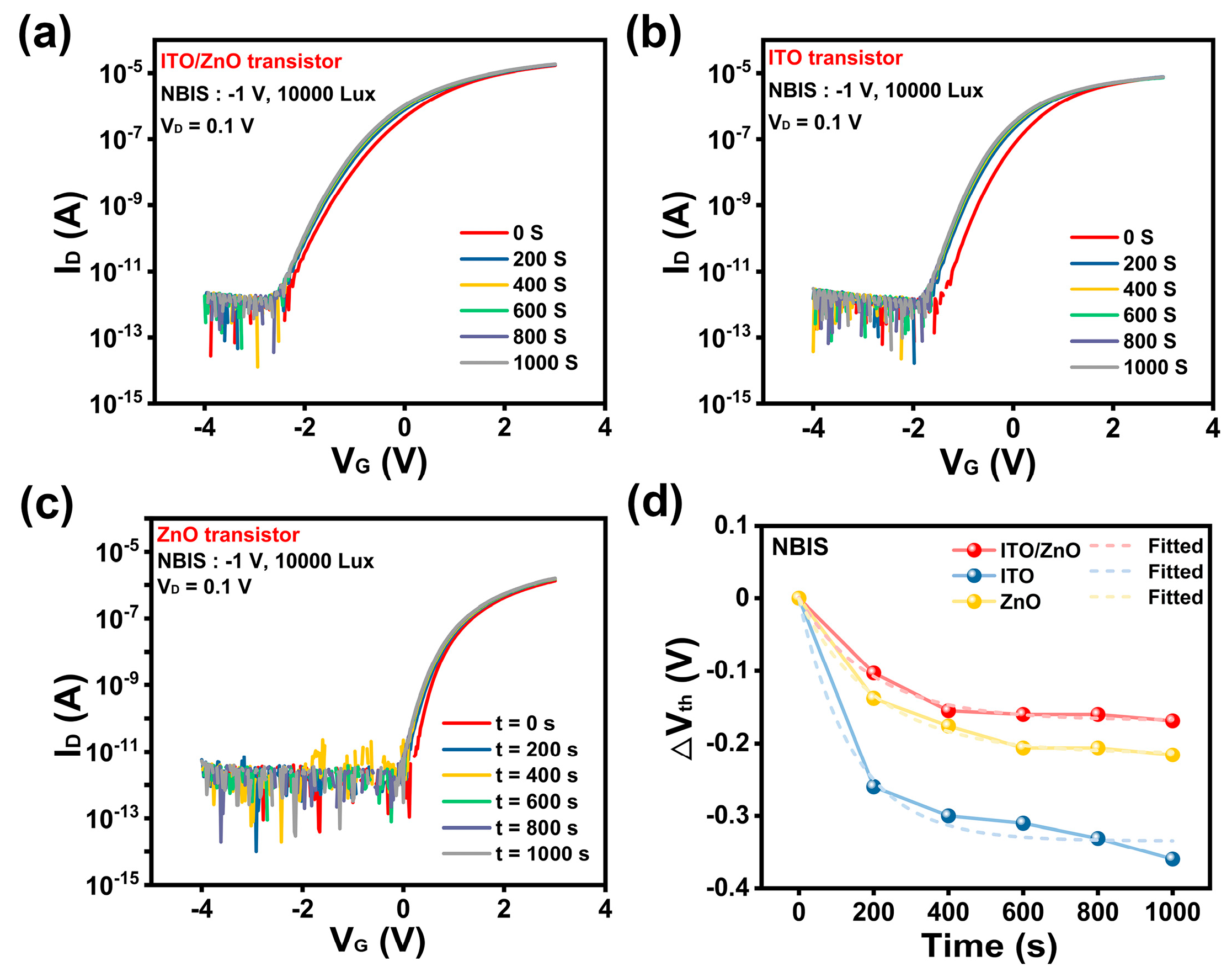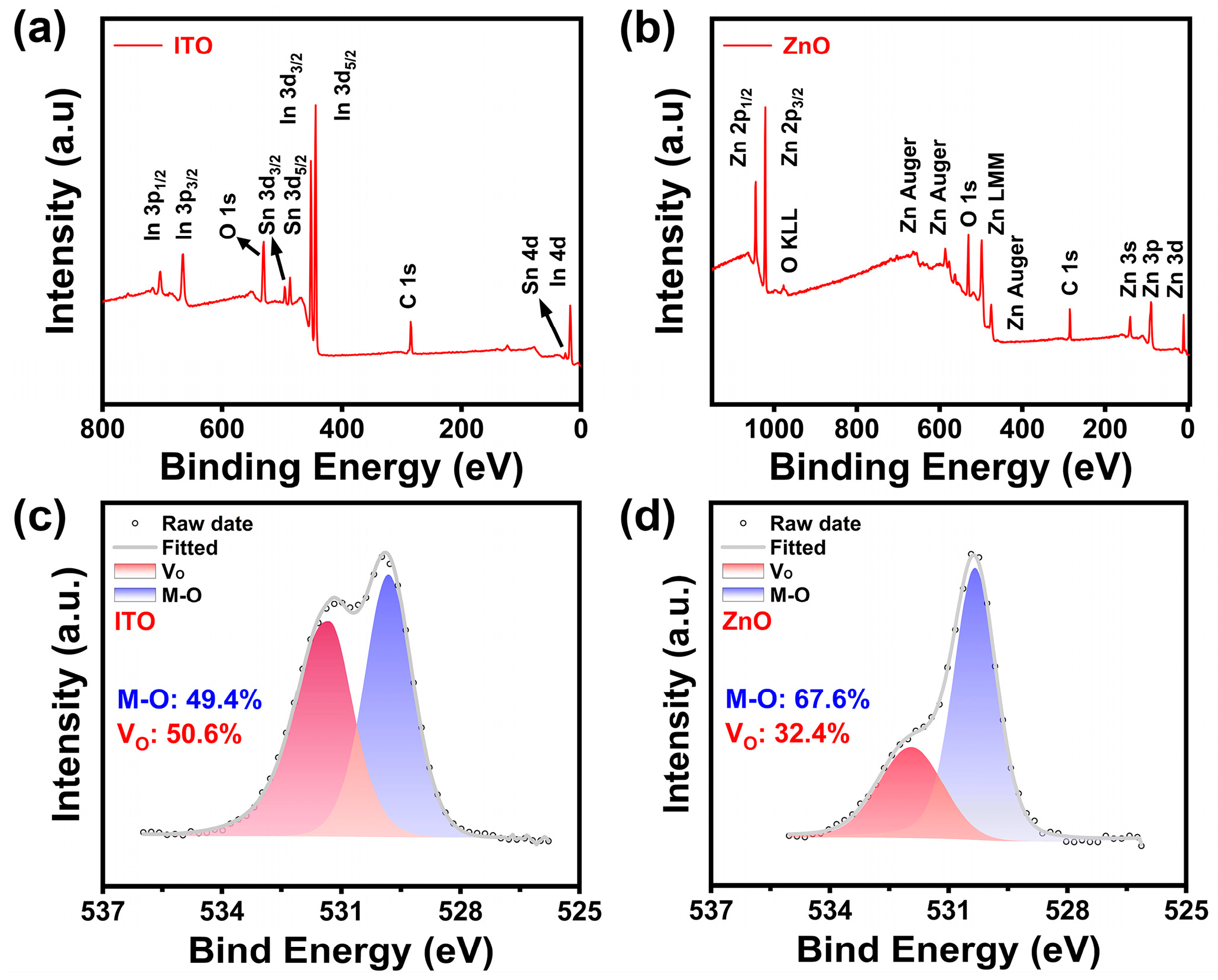Enhanced On-State Current and Stability in Heterojunction ITO/ZnO Transistors: A Mechanistic Analysis
Abstract
1. Introduction
2. Materials and Methods
3. Results and Discussion
4. Conclusions
Author Contributions
Funding
Data Availability Statement
Conflicts of Interest
References
- Zhu, H.; Shin, E.S.; Liu, A.; Ji, D.; Xu, Y.; Noh, Y.Y. Printable Semiconductors for Backplane TFTs of Flexible OLED Displays. Adv. Funct. Mater. 2019, 30, 1904588. [Google Scholar] [CrossRef]
- Kim, J.S.; Byun, J.W.; Jang, J.H.; Kim, Y.D.; Han, K.L.; Park, J.S.; Choi, B.D. A High-Reliability Carry-Free Gate Driver for Flexible Displays Using a-IGZO TFTs. IEEE Trans. Electron Devices 2018, 65, 3269–3276. [Google Scholar] [CrossRef]
- Dickson, G. The Steady Evolution of OLED Displays. Inf. Disp. 2023, 39, 21–24. [Google Scholar] [CrossRef]
- Duan, X.; Huang, K.; Feng, J.; Niu, J.; Qin, H.; Yin, S.; Jiao, G.; Leonelli, D.; Zhao, X.; Wang, Z.; et al. Novel Vertical Channel-All-Around (CAA) In-Ga-Zn-O FET for 2T0C-DRAM With High Density Beyond 4F2 by Monolithic Stacking. IEEE Trans. Electron Devices 2022, 69, 2196–2202. [Google Scholar] [CrossRef]
- Hu, Q.; Gu, C.; Zhu, S.; Li, Q.; Tong, A.; Kang, J.; Huang, R.; Wu, Y. Capacitorless DRAM Cells Based on High-Performance Indium-Tin-Oxide Transistors With Record Data Retention and Reduced Write Latency. IEEE Electron Device Lett. 2023, 44, 60–63. [Google Scholar] [CrossRef]
- Tang, W.; Liu, J.; Sun, C.; Zheng, Z.; Liu, Y.; Yang, H.; Jiang, C.; Ni, K.; Gong, X.; Li, X. Low-Power and Scalable BEOL-Compatible IGZO TFT eDRAM-Based Charge-Domain Computing. IEEE Trans. Circuits Syst. I Regul. Pap. 2023, 70, 5166–5179. [Google Scholar] [CrossRef]
- Lu, J.; Shen, M.; Feng, X.; Tan, T.; Guo, H.; Lin, L.; Zhou, F.; Li, Y. p-Type Oxide Thin-Film Transistor with Unprecedented Hole Field-Effect Mobility for an All-Oxide CMOS CFET-like Inverter Suitable for Monolithic 3D Integration. Nano Lett. 2024, 24, 15260–15267. [Google Scholar] [CrossRef] [PubMed]
- Lu, W.; Lu, C.; Yang, G.; Liu, M.; Chen, K.; Liao, F.; Duan, X.; Lu, N.; Li, L. Monolithically Stacked Two Layers of a-IGZO-Based Transistors Upon a-IGZO-Based Analog/Logic Circuits. IEEE Trans. Electron Devices 2023, 70, 1697–1701. [Google Scholar] [CrossRef]
- Fu, C.; Cui, H.; Ke, S.; Zhu, Y.; Wang, X.; Yang, Y.; Wan, C.; Wan, Q. In2O3 Nanofiber Neuromorphic Transistors for Reservoir Computing. IEEE Electron Device Lett. 2023, 44, 1364–1367. [Google Scholar] [CrossRef]
- Si, M.; Andler, J.; Lyu, X.; Niu, C.; Datta, S.; Agrawal, R.; Ye, P.D. Indium-Tin-Oxide Transistors with One Nanometer Thick Channel and Ferroelectric Gating. ACS Nano 2020, 14, 11542–11547. [Google Scholar] [CrossRef] [PubMed]
- Nomura, K.; Takagi, A.; Kamiya, T.; Ohta, H.; Hirano, M.; Hosono, H. Amorphous Oxide Semiconductors for High-Performance Flexible Thin-Film Transistors. Jpn. J. Appl. Phys. 2006, 45, 4303. [Google Scholar] [CrossRef]
- Kim, M.S.; Kim, H.T.; Jung, S.; Kim, Y.W.; Lee, S.; Kim, H.J. Enhanced Electrical Properties and Stability in IGZO TFTs via Low-Temperature Activation with MgO(x) Layer. ACS Appl. Mater. Interfaces 2024, 16, 41127–41133. [Google Scholar] [CrossRef] [PubMed]
- Chen, Z.; Yang, J.; Ding, X.; Li, X.; Zhang, J. High-Performance Fully Thermal ALD-Processed IGZO Thin Film Transistors. IEEE Trans. Electron Devices 2024, 71, 1963–1968. [Google Scholar] [CrossRef]
- Xu, X.; Zhang, L.; Shao, Y.; Chen, Z.; Le, Y.; Zhang, S. Amorphous Indium Tin Oxide Thin-Film Transistors Fabricated by Cosputtering Technique. IEEE Trans. Electron Devices 2016, 63, 1072–1077. [Google Scholar] [CrossRef]
- Park, S.Y.; Ji, K.H.; Jung, H.Y.; Kim, J.-I.; Choi, R.; Son, K.S.; Ryu, M.K.; Lee, S.; Jeong, J.K. Improvement in the device performance of tin-doped indium oxide transistor by oxygen high pressure annealing at 150 °C. Appl. Phys. Lett. 2012, 100, 162108. [Google Scholar] [CrossRef]
- Li, S.; Tian, M.; Gao, Q.; Wang, M.; Li, T.; Hu, Q.; Li, X.; Wu, Y. Nanometre-thin indium tin oxide for advanced high-performance electronics. Nat. Mater. 2019, 18, 1091–1097. [Google Scholar] [CrossRef]
- Yang, H.; Zhou, X.; Lu, L.; Zhang, S. Investigation to the Carrier Transport Properties in Heterojunction-Channel Amorphous Oxides Thin-Film Transistors Using Dual-Gate Bias. IEEE Electron Device Lett. 2023, 44, 68–71. [Google Scholar] [CrossRef]
- Lee, J.; Chung, D.S. Heterojunction oxide thin film transistors: A review of recent advances. J. Mater. Chem. C 2023, 11, 5241–5256. [Google Scholar] [CrossRef]
- Kim, J.-I.; Ji, K.H.; Jung, H.Y.; Park, S.Y.; Choi, R.; Jang, M.; Yang, H.; Kim, D.-H.; Bae, J.-U.; Kim, C.D.; et al. Improvement in both mobility and bias stability of ZnSnO transistors by inserting ultra-thin InSnO Layer at the gate insulator/channel interface. Appl. Phys. Lett. 2011, 99, 122102. [Google Scholar] [CrossRef]
- Sanctis, S.; Krausmann, J.; Guhl, C.; Schneider, J.J. Stacked indium oxide/zinc oxide heterostructures as semiconductors in thin film transistor devices: A case study using atomic layer deposition. J. Mater. Chem. C 2018, 6, 464–472. [Google Scholar] [CrossRef]
- Marrs, M.A.; Moyer, C.D.; Bawolek, E.J.; Cordova, R.J.; Trujillo, J.; Raupp, G.B.; Vogt, B.D. Control of Threshold Voltage and Saturation Mobility Using Dual-Active-Layer Device Based on Amorphous Mixed Metal–Oxide–Semiconductor on Flexible Plastic Substrates. IEEE Trans. Electron Devices 2011, 58, 3428–3434. [Google Scholar] [CrossRef]
- Jeon, S.; Kim, S.I.; Park, S.; Song, I.; Park, J.; Kim, S.; Kim, C. Low-Frequency Noise Performance of a Bilayer InZnO–InGaZnO Thin-Film Transistor for Analog Device Applications. IEEE Electron Device Lett. 2010, 31, 1128–1130. [Google Scholar] [CrossRef]
- Chen, Y.H.; Ma, D.G.; Sun, H.D.; Chen, J.S.; Guo, Q.X.; Wang, Q.; Zhao, Y.B. Organic semiconductor heterojunctions: Electrode-independent charge injectors for high-performance organic light-emitting diodes. Light Sci. Appl. 2016, 5, e16042. [Google Scholar] [CrossRef] [PubMed]
- Lee, M.; Jo, J.W.; Kim, Y.J.; Choi, S.; Kwon, S.M.; Jeon, S.P.; Facchetti, A.; Kim, Y.H.; Park, S.K. Corrugated Heterojunction Metal-Oxide Thin-Film Transistors with High Electron Mobility via Vertical Interface Manipulation. Adv. Mater. 2018, 30, e1804120. [Google Scholar] [CrossRef]
- Ji, X.; Yuan, Y.; Yin, X.; Yan, S.; Xin, Q.; Song, A. High-Performance Thin-Film Transistors With Sputtered IGZO/Ga2O3 Heterojunction. IEEE Trans. Electron Devices 2022, 69, 6783–6788. [Google Scholar] [CrossRef]
- Wakana, H.; Kawamura, T.; Fujii, K.; Uchiyama, H.; Hatano, M. P-17: Amorphous ZTO/ITO Stacked-Channel TFTs with Field Effect Mobility over 50 cm2/Vs and Resistant to Channel Thickness Dispersion. SID Symp. Dig. Tech. Pap. 2010, 41, 1287–1290. [Google Scholar] [CrossRef]
- AlGhamdi, W.S.; Fakieh, A.; Faber, H.; Lin, Y.-H.; Lin, W.-Z.; Lu, P.-Y.; Liu, C.-H.; Salama, K.N.; Anthopoulos, T.D. Impact of layer thickness on the operating characteristics of In2O3/ZnO heterojunction thin-film transistors. Appl. Phys. Lett. 2022, 121, 233503. [Google Scholar] [CrossRef]
- Liu, G.X.; Liu, A.; Shan, F.K.; Meng, Y.; Shin, B.C.; Fortunato, E.; Martins, R. High-performance fully amorphous bilayer metal-oxide thin film transistors using ultra-thin solution-processed ZrOx dielectric. Appl. Phys. Lett. 2014, 105, 113509. [Google Scholar] [CrossRef]
- Lee, J.; Hassan, S.Z.; Lee, S.; Sim, H.R.; Chung, D.S. Azide-functionalized ligand enabling organic-inorganic hybrid dielectric for high-performance solution-processed oxide transistors. Nat. Commun. 2022, 13, 7021. [Google Scholar] [CrossRef]
- Lee, S.; Mativenga, M.; Jang, J. Removal of Negative-Bias-Illumination-Stress Instability in Amorphous-InGaZnO Thin-Film Transistors by Top-Gate Offset Structure. IEEE Electron Device Lett. 2014, 35, 930–932. [Google Scholar] [CrossRef]
- Kang, Y.S.; Lee, Y.H.; Kim, W.S.; Cho, Y.J.; Park, J.; Kim, G.; Kim, O. Relationship between Detrapping of Electrons and Negative Gate Bias during Recovery Process in a-InGaZnO Thin Film Transistors. Phys. Status Solidi (A) 2019, 216, 1800621. [Google Scholar] [CrossRef]
- Park, J.C.; Lee, H.-N. Improvement of the Performance and Stability of Oxide Semiconductor Thin-Film Transistors Using Double-Stacked Active Layers. IEEE Electron Device Lett. 2012, 33, 818–820. [Google Scholar] [CrossRef]
- Liang, L.; Zhang, H.; Li, T.; Li, W.; Gao, J.; Zhang, H.; Guo, M.; Gao, S.; He, Z.; Liu, F.; et al. Addressing the Conflict between Mobility and Stability in Oxide Thin-film Transistors. Adv. Sci. 2023, 10, e2300373. [Google Scholar] [CrossRef] [PubMed]
- Cho, M.H.; Choi, C.H.; Jeong, J.K. Comparative Study of Atomic Layer Deposited Indium-Based Oxide Transistors with a Fermi Energy Level-Engineered Heterojunction Structure Channel through a Cation Combinatorial Approach. ACS Appl. Mater. Interfaces 2022, 14, 18646–18661. [Google Scholar] [CrossRef] [PubMed]
- Kim, K.-A.; Park, M.-J.; Lee, W.-H.; Yoon, S.-M. Characterization of negative bias-illumination-stress stability for transparent top-gate In-Ga-Zn-O thin-film transistors with variations in the incorporated oxygen content. J. Appl. Phys. 2015, 118, 234504. [Google Scholar] [CrossRef]
- Park, H.; Oh, D.S.; Hong, W.; Kang, J.; Lee, G.B.; Shin, G.H.; Choi, Y.K.; Im, S.G.; Choi, S.Y. Hybrid Gate Dielectric of MoS2 Transistors for Enhanced Photo-Electronic Stability. Adv. Mater. Interfaces 2021, 8, 2100599. [Google Scholar] [CrossRef]
- Lee, J.-M.; Cho, I.-T.; Lee, J.-H.; Kwon, H.-I. Bias-stress-induced stretched-exponential time dependence of threshold voltage shift in InGaZnO thin film transistors. Appl. Phys. Lett. 2008, 93, 093504. [Google Scholar] [CrossRef]
- Huang, T.; Mo, C.; Cui, M.; Li, M.; Ji, P.; Tan, H.; Zhang, X.; Zhuge, L.; Wu, X. Ion behavior impact on ITO thin film fabrication via DC magnetron sputtering with external anode. Vacuum 2024, 221, 112848. [Google Scholar] [CrossRef]
- Abdel-wahab, M.S.; Jilani, A.; Yahia, I.S.; Al-Ghamdi, A.A. Enhanced the photocatalytic activity of Ni-doped ZnO thin films: Morphological, optical and XPS analysis. Superlattices Microstruct. 2016, 94, 108–118. [Google Scholar] [CrossRef]
- Lee, H.; Lee, S.; Kim, Y.; Siddik, A.B.; Billah, M.M.; Lee, J.; Jang, J. Improvement of Stability and Performance of Amorphous Indium Gallium Zinc Oxide Thin Film Transistor by Zinc-Tin-Oxide Spray Coating. IEEE Electron Device Lett. 2020, 41, 1520–1523. [Google Scholar] [CrossRef]







| Sample | μFE cm2/Vs | Leakage Current pA | On/Off |
|---|---|---|---|
| ITO/ZnO (this work) | 84.4 | 0.1 | over 109 |
| ITO/ZTO [26] | ~50 | 1 | over 108 |
| In2O3/ZnO [27] | ~50 | 10–100 | ~108 |
| In2O3/IZO [28] | 37.9 | 0.1 | ~109 |
| In2O3/ZnO [29] | ~50 | 10 | ~107 |
| Sample | On-State Current μA/μm | Vth V | SS mV/Decade |
|---|---|---|---|
| ITO/ZnO | 19.2 | −1.80 | 85.7 |
| ITO | 11.9 | −1.48 | 90.2 |
| ZnO | 1.06 | 0.51 | 76.7 |
Disclaimer/Publisher’s Note: The statements, opinions and data contained in all publications are solely those of the individual author(s) and contributor(s) and not of MDPI and/or the editor(s). MDPI and/or the editor(s) disclaim responsibility for any injury to people or property resulting from any ideas, methods, instructions or products referred to in the content. |
© 2025 by the authors. Licensee MDPI, Basel, Switzerland. This article is an open access article distributed under the terms and conditions of the Creative Commons Attribution (CC BY) license (https://creativecommons.org/licenses/by/4.0/).
Share and Cite
Xu, D.; Yi, T.; Dong, J.; Liu, L.; Han, D.; Zhang, X. Enhanced On-State Current and Stability in Heterojunction ITO/ZnO Transistors: A Mechanistic Analysis. Nanomaterials 2025, 15, 248. https://doi.org/10.3390/nano15030248
Xu D, Yi T, Dong J, Liu L, Han D, Zhang X. Enhanced On-State Current and Stability in Heterojunction ITO/ZnO Transistors: A Mechanistic Analysis. Nanomaterials. 2025; 15(3):248. https://doi.org/10.3390/nano15030248
Chicago/Turabian StyleXu, Dengqin, Tingchen Yi, Junchen Dong, Lifeng Liu, Dedong Han, and Xing Zhang. 2025. "Enhanced On-State Current and Stability in Heterojunction ITO/ZnO Transistors: A Mechanistic Analysis" Nanomaterials 15, no. 3: 248. https://doi.org/10.3390/nano15030248
APA StyleXu, D., Yi, T., Dong, J., Liu, L., Han, D., & Zhang, X. (2025). Enhanced On-State Current and Stability in Heterojunction ITO/ZnO Transistors: A Mechanistic Analysis. Nanomaterials, 15(3), 248. https://doi.org/10.3390/nano15030248







